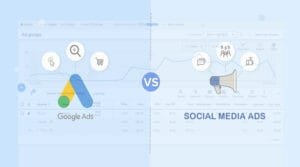Enticing a new patient is a mute precedent for a healthcare clinic. Google Ads and online networks Ads provide a powerful means of reaching powerful patients in the current virtual environment. However, in order to maximize your advertising budget and achieve your clinic’s growth objectives, choosing the correct platform or combination of stages is crucial. The present blog post explores the main differences between Google Ads and Digital Media Ads, allowing you to decide which one is most suitable for your clinical practice.
Understanding Google Ads
Google AdWords, once known as Google AdWords, is a pay-per-click (PPC) advertising platform that entitles you to display your ad on Google’s search engine results pages (SERPs) and on its huge World of Companion website. When a patient has the ability to conduct a patient search for words that are related to your assistance (e.g. Your ad may appear alongside organic search results, ‘cardiologist near me ‘, or ‘best dermatologist in town name ”.
The Advantages of Google Ads for Medical Practices
- Target Reach: Search Engine Google Ads allows you to target a user actively looking for medical assistance. You reach people who are already interested in the person you supply with this intent-based targeting tool.
- Immediate Visibility: Your ad can appear near the top of the SERPs at once and provide immediate visibility to promise a patient.
- Measurable Results: Google Ads provides powerful tracking tools that allow you to monitor important metrics such as impressions, conversions, and cost per click. The current data-driven technique enables you to enhance your political campaign for maximum returns.
- Regional Targeting: Allows you to target patients in your local area in a way that ensures that you reach the correct demographic.
Understanding Social Media Ads
Online networks Ads, on top of channels such as Facebook, Instagram, and LinkedIn, enable patients to be aligned with their demographics, interests, actions, and different target standards. Unlike Google Ads, which target users based on their search objectives, online networks establish target users on their profiles and online projects.
The Advantages of Social Media Ads for Medical Practices
- Farinaceous Targeting: Social networking sites provide you with a highly detailed targeting option, allowing you to target a particular long-term demographic (time, sex, location, passions, etc.). :).
- Label Understanding: Virtual medium advertising can continue to be productive in terms of structure label consciousness and connection to the ability patient.
- Ocular attractiveness: Channels appreciate that Instagram is a pictorial driving force, allowing you to present your clinic’s facilities, staff, and longstanding testimony through prosecuted photographs and videos.
- Retargeting: You can retarget users who have previously been in contact with your clinic’s website or an online network page so that your practice is always at the forefront.
Google Ads vs. Social Media Ads: Which is Right for You?
The best choice for your medical practice depends on your specific goals and target audience.
- Choose Google Ads if: You’d like to find a patient, hard-working helper, choose the Google search engine. You’re focused on driving immediate appointments and creating leads. You’ve got a clear understanding of the words that your target congregation uses.
- Choose Social Media Ads if: You want to create a symbol consciousness and involve a promising patient before they are energetically searching for a healthcare supplier, choose online community Ads. To get detailed demographics, otherwise the curiosity group. You’ve got a sightwise appeal to share, huh?
Can You Use Both?
Often, the combination of search engine (google) advertising and social networking advertising is the most suitable method for merging both types of advertising. This combined method enables you.
- Capture patients at unique periods: To achieve the possibility of patients equally while they are actively seeking care via Google Ads and when they shop online via online communities via online communities.
- Reinforce Your message: With steady messages on both media, strengthen your logo, and build trust together with your promise patient.
- Maximize your reach: By using simultaneous media, you can extend your reach and connect with a wider audience.
Key Considerations for Medical Practices
- Budget: Budgets are demanded by platforms as well, although the cost per click or the cost per impression can change significantly. In order to ensure the highest return on invested capital, carefully plan your budget and monitor your expenditure.
- HIPAA compliance: When using online networks, be aware of HIPAA legal directives on persevering aloneness. Avoid sharing protected vitality information in your ad as an alternate target.
- Campaign management: In order to operate effectively, Google Ads and Virtual medium ads need constant administration and optimization. Consider hiring a specialist if you do not have the time or expertise to run your campaign internally.
Conclusion
At the same time, Google Ads and Digital Media Ads provide a valuable opportunity for a healthcare clinic to attract new patients. You can develop a powerful advertising tactic that will increase and enhance your clinic’s internet presence by analyzing its advantages and advancing your critical strategy. Usually, the most exhaustive and effective solution is a combined technique based on the results of simultaneous stages.






